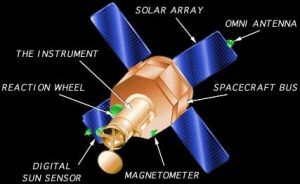What is a Reaction Wheel?
A reaction wheel is a key component in spacecraft attitude control systems. It uses the principles of angular momentum to provide precise adjustments to the orientation of a spacecraft without relying on thrusters. Reaction wheels enable a spacecraft to rotate along specific axes, helping maintain its orientation in space.

In a reaction wheel system, a spinning wheel generates torque that adjusts the spacecraft’s attitude. When the wheel accelerates or decelerates, it imparts a counteracting force to the spacecraft, allowing for fine control over its orientation. This system is essential for missions that require high precision in pointing, such as Earth observation, communications, and scientific missions.
Reaction Wheel Dynamics Explained
1. Principles of Operation
The dynamics of a reaction wheel are based on the conservation of angular momentum. When the wheel inside the system spins up or down, the spacecraft itself rotates in the opposite direction to conserve momentum. This principle of operation allows for highly accurate attitude control without the need for external forces like thrusters or fuel.
The wheel’s speed and direction can be adjusted by changing the rotational speed of the wheel. Engineers can fine-tune the spacecraft’s orientation using the reaction wheel’s dynamics to achieve precise positioning for various mission needs.
2. Torque Generation
The torque generated by a reaction wheel is a result of the rotational force applied to the wheel’s spinning mass. As the wheel accelerates or decelerates, it transfers angular momentum to the spacecraft, causing it to rotate. The amount of torque produced is proportional to the wheel’s moment of inertia and the rate at which the wheel’s speed changes.
Because of this, reaction wheels can make subtle adjustments, even in the absence of external forces like gravitational torques. This feature makes them ideal for spacecraft that require continuous and highly controlled pointing, such as telescopes and communication satellites.
Advantages of Using Reaction Wheels
1. Precision in Attitude Control
One of the primary advantages of reaction wheels is their ability to provide fine-tuned, precise control over the spacecraft’s orientation. Unlike other methods of attitude control, such as control moment gyroscopes, reaction wheels are simpler and allow for more detailed adjustments in three-dimensional space.
2. No Fuel Requirement
Another significant benefit is that reaction wheels do not rely on fuel for operation. This is a major advantage in space missions, where conserving fuel is critical for long-duration missions. Because they operate using only electrical power, reaction wheels can function for extended periods, making them suitable for deep space missions and other long-term spacecraft operations.
3. Reliability and Longevity
Reaction wheels are highly reliable and have fewer moving parts compared to other mechanical control systems. This reliability translates into fewer chances of system failure and a longer operational lifespan, which is essential for missions that last several years, such as space telescopes and scientific satellites.
Challenges in Reaction Wheel Systems
1. Saturation and Wheel Failure
One of the key challenges with reaction wheels is “saturation.” This occurs when the wheel reaches its maximum rotational speed and can no longer provide any more torque. When this happens, the spacecraft may lose its ability to control its orientation. Engineers often mitigate this by using multiple reaction wheels or combining them with other attitude control systems like magnetorquers.
2. Energy Consumption
Although reaction wheels do not use fuel, they do require electrical power to operate. The energy needed to spin the wheel at high speeds can be significant, especially on missions where power resources are limited. Solar power is typically used to supply this energy, but efficient management of power is still a challenge.
3. Complex Control Algorithms
To ensure that the reaction wheel system functions optimally, spacecraft need sophisticated control algorithms that can manage the torque generation and adjust wheel speeds accordingly. These algorithms must also account for factors such as wheel degradation over time and changes in the spacecraft’s mass distribution.
Future Developments in Reaction Wheel Technology
1. Miniaturization and Increased Efficiency
As satellite systems continue to evolve, reaction wheels are being miniaturized and made more efficient to fit smaller spacecraft. These advancements will allow for greater control and precision in smaller and more cost-effective satellites, expanding the possibilities for space missions, especially in CubeSats and small satellite applications.
2. Hybrid Systems
Some spacecraft are now using hybrid systems that combine reaction wheels with other attitude control mechanisms like control moment gyroscopes or magnetorquers. These hybrid systems take advantage of the strengths of each component, providing better performance and redundancy.
Interested in more information about spacecraft attitude control systems?
Click here to learn more about advanced technologies that enhance spacecraft stability and precision in space missions.
